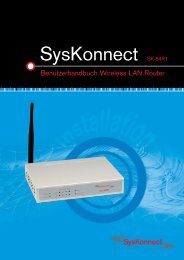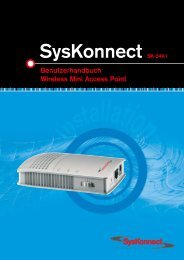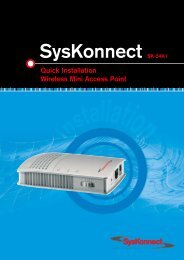Connection to the SysKonnect SK-54P1 802.11g Wireless Print Server
Connection to the SysKonnect SK-54P1 802.11g Wireless Print Server
Connection to the SysKonnect SK-54P1 802.11g Wireless Print Server
Create successful ePaper yourself
Turn your PDF publications into a flip-book with our unique Google optimized e-Paper software.
34 3 Windows Configuration<br />
Adding TCP/IP printing<br />
support<br />
Adding a TCP/IP<br />
remote printer<br />
Windows <strong>Server</strong> Configuration<br />
Windows NT4.0 <strong>Server</strong><br />
If using Windows NT 4.0, Microsoft TCP/IP printing support must be installed.<br />
• If it is already installed, add a TCP/IP remote printer, as described below.<br />
• O<strong>the</strong>rwise, install TCP/IP printing support, <strong>the</strong>n add a TCP/IP remote printer.<br />
To add TCP/IP support, proceed as follows:<br />
1. Go <strong>to</strong> START > SETTINGS > CONTROL PANEL > NETWORK.<br />
2. Select <strong>the</strong> SERVICE option.<br />
3. Ensure that Microsoft TCP/IP <strong>Print</strong>ing is enabled.<br />
If it is not enabled, select <strong>the</strong> ADD option and enable it as usual.<br />
4. If you added services in step 3, reboot <strong>the</strong> computer for <strong>the</strong> changes <strong>to</strong> take affect.<br />
To add a TCP/IP remote printer, proceed as follows:<br />
1. Go <strong>to</strong> START > SETTINGS > PRINTER.<br />
2. Invoke <strong>the</strong> “Add <strong>Print</strong>er” wizard.<br />
3. When prompted with “This printer will be managed by”, select MY COMPUTER.<br />
4. Click Next.<br />
5. Select ADD PORT.<br />
6. Select LPR PORT.<br />
7. Click NEW PORT.<br />
8. In <strong>the</strong> “Name of Address of server providing lpd:” dialog box, enter <strong>the</strong> <strong>SysKonnect</strong> <strong>Print</strong><br />
<strong>Server</strong>'s IP address.<br />
9. In <strong>the</strong> “Name of printer or print queue on that server” dialog box, enter <strong>the</strong> appropriate<br />
logical printer number (e.g. L1) as previously configured on <strong>the</strong> <strong>SysKonnect</strong> <strong>Print</strong> <strong>Server</strong>.<br />
10. Click OK.<br />
11. When returned <strong>to</strong> <strong>the</strong> “<strong>Print</strong>er Ports” window, click CLOSE.<br />
12. Install your printer driver as usual.<br />
13. When prompted whe<strong>the</strong>r or not <strong>the</strong> printer will be shared, select <strong>the</strong> Sharing radio but<strong>to</strong>n.<br />
14. In <strong>the</strong> “Shared” dialog box, enter <strong>the</strong> shared printer name.<br />
(The shared name is how o<strong>the</strong>r users will see this printer.)<br />
15. Click OK <strong>to</strong> save and exit.<br />
Client PCs can now be configured as described in section "Client PC configuration" on page<br />
21.<br />
Windows 2000/2003 <strong>Server</strong><br />
1. Start <strong>the</strong> “Add <strong>Print</strong>er” wizard.<br />
2. Select NETWORK PRINTER.<br />
3. Click NEXT <strong>to</strong> browse for <strong>the</strong> <strong>SysKonnect</strong> <strong>Print</strong> <strong>Server</strong>.<br />
4. Locate and double-click <strong>the</strong> <strong>SysKonnect</strong> <strong>Print</strong> <strong>Server</strong>.<br />
5. Select <strong>the</strong> desired port.<br />
6. Click NEXT.<br />
A message like one of <strong>the</strong> following will be displayed:





